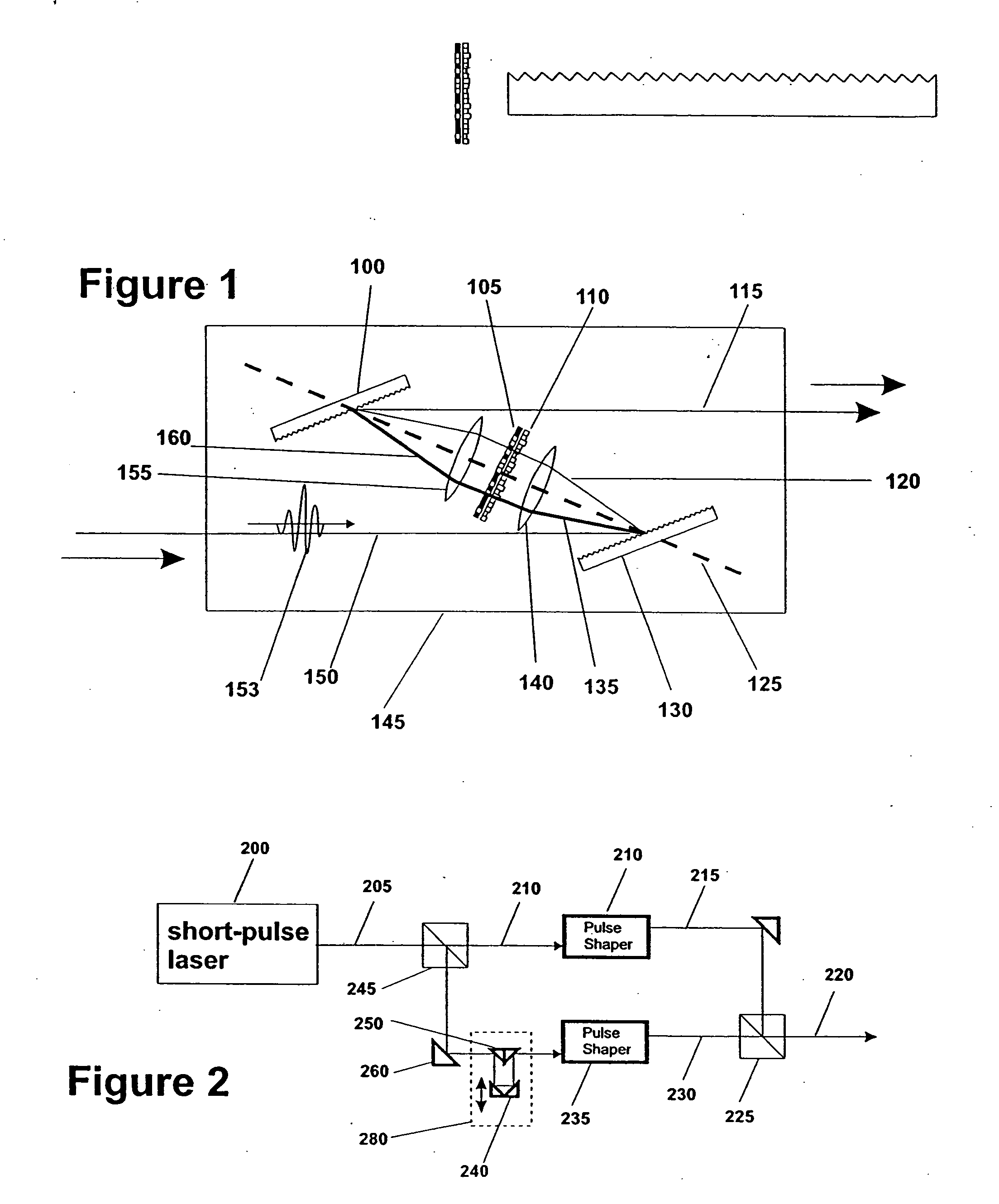Quantum resonance analytical instrument
an analytical instrument and quantum resonance technology, applied in instruments, interferometric spectrometry, optical radiation measurement, etc., can solve the problem of prior art in which shaped pulses have been used to recognize, identify or detect specific molecules or substances
- Summary
- Abstract
- Description
- Claims
- Application Information
AI Technical Summary
Problems solved by technology
Method used
Image
Examples
embodiment # 1
Embodiment #1
Apparatus and Method for Detecting Anthrax Spores or Other Pathogens
[0050] The apparatus of FIG. 12 includes a source 1200 of femtosecond light pulses, a pulse shaper 1210, a fluorescence spectrometer 1237, optics 1270 to direct shaped light pulses to a sample of fluid in a sample holder 1265, means 1237 for analyzing the spectrum and polarization of light emitted by the sample in response to illumination by a light pulse, and means 1217 for controlling the pulse shaper 1210. In the example shown in FIG. 12, the sample holder is a transparent capillary tube 1265, a source reservoir 1230, the tubing 1215 and 1250, and the receiver reservoir 1255. However, the sample holder can be a microscope slide, a “gene array chip”, a clamp, or any other device that can hold a sample for analysis. In fact, the sample holder can be the sample itself of part of the sample's environment, if, for example, the sample is a letter in a mail sorting facility, dust on a table surface, or mic...
embodiment # 2
Embodiment #2
A Pulse Shaper with Phase, Amplitude and Polarization Control
[0054] The apparatus in FIG. 7 is a pulse shaper for light pulses, on the order of femtoseconds to nanoseconds in duration. An original collimated pulse 701 is split by a polarizing beamsplitter 700 into two pulses 775, 702 with orthogonal polarization. In the path of each pulse, a non-polarization pulse shaper 710, 735, 740 is placed. As shown in FIG. 1, in the non-polarization pulse shapers, a dispersive element 130 such as a diffraction grating or a prism spreads the spectrum of an original light pulse out to a line. The diverging light in the spread spectrum is collimated by a lens 140 or by a curved mirror, then is passed through one or more spatial light modulators 110,105 to adjust the relative phase and amplitude of each spectral component relative to the other components. After passing through the spatial light modulators, the light is focused to a point by a second lens 155 onto a second diffraction...
embodiment # 3
Embodiment #3
Scanning Near-Field Optical Probe Microscope
[0055] As shown in FIG. 4, a shaped pulse of light may be coupled into an optical fiber 490 and thence into the optics 455, 460 of a near-field scanning optical probe microscope 450. Scattered light from the pulse and fluorescent light stimulated by the pulse may be gathered either by the optical fiber 447 or by other means such as a microscope objective and analyzed with respect to spectrum, polarization and phase by means of a spectrometer or time-resolved spectrometer and other suitable optics 435. Phase analysis requires interfering the gathered light with a portion of the original pulse and examining the position of fringes in the interference pattern. Scattered light may be analyzed for features in the absorption spectrum, while emitted fluorescent light may be analyzed for features in the emission spectrum. Any particular substance at the locus of the evanescent light field from the tip of the microscope probe will be ...
PUM
 Login to View More
Login to View More Abstract
Description
Claims
Application Information
 Login to View More
Login to View More - R&D
- Intellectual Property
- Life Sciences
- Materials
- Tech Scout
- Unparalleled Data Quality
- Higher Quality Content
- 60% Fewer Hallucinations
Browse by: Latest US Patents, China's latest patents, Technical Efficacy Thesaurus, Application Domain, Technology Topic, Popular Technical Reports.
© 2025 PatSnap. All rights reserved.Legal|Privacy policy|Modern Slavery Act Transparency Statement|Sitemap|About US| Contact US: help@patsnap.com



